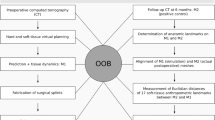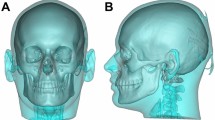Abstract
Background
This study aimed at a preliminary evaluation of the accuracy of computed three-dimensional (3D) predictions in orthognathic surgery by comparing predicted and real postoperative results.
Methods
Pre- and postoperative 3D photographs and time-matching computed tomography (CT) and cone-beam CT scans of the face of 13 patients with dentofacial deformities were analyzed. Three-dimensional photographs were fused with preoperative CT data using dedicated software (3dMDvultus, version 2.2.0.8). Postoperative CT data were superposed on the preoperative skull. With an activated rendering function, the osteotomies were simulated in the preoperative CT data and the bony segments moved to their real postoperative position, resulting in a textured soft tissue prediction. This computed skin surface was compared with the real postoperative result by dividing the face into a surgically treated lower half and an untreated upper half. A statistical quantitative analysis of the surfaces was performed.
Results
The mean differences between surfaces were +0.27 mm for the untreated upper half and –0.64 mm for the surgically treated lower half (p < 0.001). Averaged distributions of absolute errors showed more discrepancies between predicted and real postoperative results in the lower half of the face. Errors exceeding 3 mm were encountered in 4 % of the upper halves versus 29.8 % of the lower halves (p < 0.001).
Conclusions
The accuracy of a specific software platform for predicting 3D soft tissue changes after surgery was insufficient.
Level of Evidence IV
This journal requires that authors assign a level of evidence to each article. For a full description of these Evidence-Based Medicine ratings, please refer to the Table of Contents or the online Instructions to Authors www.springer.com/00266.







Similar content being viewed by others
References
Aboul-Hosn Centenero S, Hernández-Alfaro F (2012) 3D Planning in orthognathic surgery: CAD/CAM surgical splints and prediction of the soft and hard tissues results: Our experience in 16 cases. J Cranio Maxillofac Surg 40:162–168
Albuquerque MA, Gaia BF, Cavalcanti MGP (2011) Comparison between multislice and cone-beam computerized tomography in the volumetric assessment of cleft palate. Oral Surg Oral Med Oral Path Oral Radiol Endod 112:249–257
Aldridge K, Boyadjiev SA, Capone GT, DeLeon VB, Richtsmeier JT (2005) Precision and error of three-dimensional phenotypic measures acquired from 3dMD photogrammetric images. Am J Med Genet A 138A:247–253
Alves PV, Bolognese AM, Zhao L (2007) Three-dimensional computerized orthognathic surgical treatment planning. Clin Plast Surg 34:427–436
Bergman RT, Waschak J, Borzabadi-Farahani A, Murphy NC (2013) Longitudinal study of cephalometric soft tissue profile traits between the ages of 6 and 18 years. Angle Orthod. doi:10.2319/041513-291.1
Carvalho Fde A, Cevidanes LH, da Motta AT, de Oliveira Almeida MA, Phillips C (2010) Three-dimensional assessment of mandibular advancement 1 year after surgery. Am J Orthod Dentofacial Orthop 137:e1–e12
Cevidanes LHS, Styner M, Phillips C, Oliveira AEF, Tulloch JFC (2007) 3D Morphometric changes 1 year after surgery. In: Proceedings in ISBI, Metro Washington, Washington, pp 1332–1335
Cevidanes LH, Tucker S, Styner M, Kim H, Chapuis J, Reyes M, Jaskolka M (2010) Three-dimensional surgical simulation. Am J Orthod Dentofacial Orthop 138:361–371
DerSimonian R, Laird N (1986) Meta-analysis in clinical trials. Control Clin Trials 7:177–188
Egger M, Davey Smith G, Altman DG (2001) Systematic reviews in health care: metaanalysis in context. BMJ Books, London
Hajeer MY, Ayoub AF, Millett DT, Bock M, Siebert JP (2002) Three-dimensional imaging in orthognathic surgery: the clinical application of a new method. Int J Adult Orthodon Orthognath Surg 17:318–330
Harrell WE, Hatcher DC, Bolt RL (2002) In search of anatomic truth: 3-dimensional digital modeling and the future of orthodontics. Am J Orthod Dentofacial Orthop 122:325–330
Hashimoto K, Arai Y, Iwai K, Araki M, Kawashima S, Terakado M (2003) A comparison of a new limited cone beam computed tomography machine for dental use with a multidetector row helical CT machine. Oral Surg Oral Med Oral Pathol Oral Radiol Endod 95:371–377
Higgins JPT, Thompson SG, Deeks JJ, Altman DG (2003) Measuring inconsistency in meta-analyses. BMJ 327:557–560
Jackson D, White IR, Thompson SG (2010) Extending DerSimonian and Laird’s methodology to perform multivariate random effects meta-analyses. Stat Med 29:1282–1297
Loubele M, Maes F, Schutyser F, Marchal G, Jacobs R, Suetens P (2006) Assessment of bone segmentation quality of cone-beam CT versus multislice spiral CT: a pilot study. Oral Surg Oral Med Oral Pathol Oral Radiol Endod 102:225–234
Mischkowski RA, Scherer P, Ritter L, Neugebauer J, Keeve E, Zoeller JE (2008) Diagnostic quality of multiplanar reformations obtained with a newly developed cone beam device for maxillofacial imaging. Dentomaxillofac Radiol 37:1–9
Plooij JM, Maal TJ, Haers P, Borstlap WA, Kuijpers-Jagtman AM, Bergé SJ (2011) Digital three-dimensional image fusion processes for planning and evaluating orthodontics and orthognathic surgery: a systematic review. Int J Oral Maxillofac Surg 40:341–352
Plooij JM, Swennen GR, Rangel FA, Maal TJJ, Schutyser FAC, Bronkhorst EM, Bergé SJ (2009) Evaluation of reproducibility and reliability of 3D soft tissue analysis using 3D stereophotogrammetry. Int J Oral Maxillofac Surg 38:267–273
Poisot T (2011) The digitize package: extracting numerical data from scatter plots. R J 3:25–26
Reed GF, Meade BD, Steinhoff MC (1995) The reverse cumulative distribution plot: a graphic method for exploratory analysis of antibody data. Pediatrics 96:600–603
Rucker G, Schwarzer G, Carpenter J, Olkin I (2009) Why add anything to nothing? The arcsine difference as a measure of treatment effect in meta-analysis with zero cells. Stat Med 28:721–738
Schendel SA, Jacobson R (2009) Three-dimensional imaging and computer simulation for office-based surgery. J Oral Maxillofac Surg 67:2107–2114
Swennen GR, Mollemans W, Schutyser F (2009) Three-dimensional treatment planning of orthognathic surgery in the era of virtual imaging. J Oral Maxillofac Surg 67:2080–2092
Tucker S, Cevidanes LHS, Styner, Kim H, Reyes M, Proffit W, Turvey T (2010) Comparison of actual surgical outcomes and 3-dimensional surgical simulations. J Oral Maxillofac Surg 68:2412–2421
Zinser MJ, Zachow S, Sailer HF (2012) Bimaxillary rotation advancement procedures in patients with obstructive sleep apnea: a 3-dimensional airway analysis of morphological changes. Int J Oral Maxillofac Surg. doi:10.1016/j.ijom.2012.08.002
Author information
Authors and Affiliations
Corresponding author
Rights and permissions
About this article
Cite this article
Terzic, A., Combescure, C. & Scolozzi, P. Accuracy of Computational Soft Tissue Predictions in Orthognathic Surgery From Three-Dimensional Photographs 6 Months After Completion of Surgery: A Preliminary Study of 13 Patients. Aesth Plast Surg 38, 184–191 (2014). https://doi.org/10.1007/s00266-013-0248-4
Received:
Accepted:
Published:
Issue Date:
DOI: https://doi.org/10.1007/s00266-013-0248-4




